- Published on
Introduction to Statistics in Python
40 min read
- Authors
- Name
- Kiarash Soleimanzadeh
- https://go.kiarashs.ir/twitter
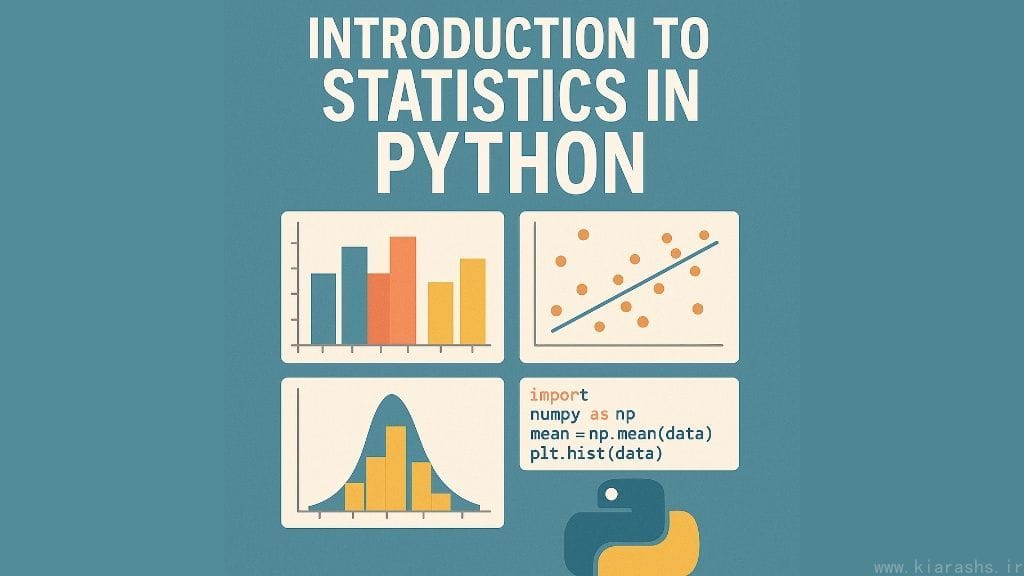
Table of Contents
- Summary Statistics
- What is statistics?
- Descriptive and inferential statistics
- Data type classification
- Measures of center
- Mean and median
- Mean vs. median
- Measures of spread
- Quartiles, quantiles, and quintiles
- Variance and standard deviation
- Finding outliers using IQR
- Random Numbers and Probability
- What are the chances?
- With or without replacement?
- Calculating probabilities
- Sampling deals
- Discrete distributions
- Creating a probability distribution
- Identifying distributions
- Expected value vs. sample mean
- Continuous distributions
- Which distribution?
- Data back-ups
- Simulating wait times
- The binomial distribution
- Simulating sales deals
- Calculating binomial probabilities
- How many sales will be won?
- More Distributions and the Central Limit Theorem
- The normal distribution
- Distribution of Amir's sales
- Probabilities from the normal distribution
- Simulating sales under new market conditions
- Which market is better?
- The central limit theorem
- Visualizing sampling distributions
- The CLT in action
- The mean of means
- The Poisson distribution
- Identifying lambda
- Tracking lead responses
- More probability distributions
- Distribution dragging and dropping
- Modeling time between leads
- The t-distribution
- Correlation and Experimental Design
- Correlation
- Guess the correlation
- Relationships between variables
- Correlation caveats
- What can't correlation measure?
- Transforming variables
- Does sugar improve happiness?
- Confounders
- Design of experiments
- Study types
- Longitudinal vs. cross-sectional studies
Download datasets from here.
Statistics is the study of how to collect, analyze, and draw conclusions from data. It's a hugely valuable tool that you can use to bring the future into focus and infer the answer to tons of questions. For example, what is the likelihood of someone purchasing your product, how many calls will your support team receive, and how many jeans sizes should you manufacture to fit 95% of the population? In this course, you'll discover how to answer questions like these as you grow your statistical skills and learn how to calculate averages, use scatterplots to show the relationship between numeric values, and calculate correlation. You'll also tackle probability, the backbone of statistical reasoning, and learn how to use Python to conduct a well-designed study to draw your own conclusions from data.
import pandas as pd
import numpy as np
import warnings
import matplotlib.pyplot as plt
import matplotlib as mpl
plt.rcParams['figure.figsize'] = [7, 5]
pd.set_option('display.expand_frame_repr', False)
warnings.filterwarnings("ignore")
mpl.rcParams['axes.grid'] = True
plt.style.use('seaborn')
Summary Statistics
Summary statistics gives you the tools you need to boil down massive datasets to reveal the highlights. In this section, you'll explore summary statistics including mean, median, and standard deviation, and learn how to accurately interpret them. You'll also develop your critical thinking skills, allowing you to choose the best summary statistics for your data.
What is statistics?
Descriptive and inferential statistics
Statistics can be used to answer lots of different types of questions, but being able to identify which type of statistics is needed is essential to drawing accurate conclusions. In this exercise, you'll sharpen your skills by identifying which type is needed to answer each question.
Identify which questions can be answered with descriptive statistics and which questions can be answered with inferential statistics.

Data type classification
There are two main types of data: numeric and categorical. Numeric variables can be classified as either discrete or continuous, and categorical variables can be classified as either nominal or ordinal. These characteristics of a variable determine which ways of summarizing your data will work best. Map each variable to its data type by dragging each item and dropping it into the correct data type.

Measures of center
Mean and median
In this section, you'll be working with the 2018 Food Carbon Footprint Index from nu3. The food_consumption dataset contains information about the kilograms of food consumed per person per year in each country in each food category (consumption) as well as information about the carbon footprint of that food category (co2_emissions) measured in kilograms of carbon dioxide, or CO2, per person per year in each country.
In this exercise, you'll compute measures of center to compare food consumption in the US and Belgium using your pandas and numpy skills.
pandas is imported as pd for you and food_consumption is pre-loaded.
Instruction:
- Import
numpywith the aliasnp. - Create two DataFrames: one that holds the rows of food_consumption for 'Belgium' and another that holds rows for 'USA'. Call these be_consumption and usa_consumption.
- Calculate the mean and median of kilograms of food consumed per person per year for both countries.
food_consumption = pd.read_csv('./datasets/food_consumption.csv', index_col=0)
display(food_consumption.head())
| country | food_category | consumption | co2_emission | |
|---|---|---|---|---|
| 1 | Argentina | pork | 10.51 | 37.20 |
| 2 | Argentina | poultry | 38.66 | 41.53 |
| 3 | Argentina | beef | 55.48 | 1712.00 |
| 4 | Argentina | lamb_goat | 1.56 | 54.63 |
| 5 | Argentina | fish | 4.36 | 6.96 |
import numpy as np
# Filter for Belgium
be_consumption =food_consumption[food_consumption['country'] == 'Belgium']
# Filter for USA
usa_consumption = food_consumption[food_consumption['country'] == 'USA']
# Calculate mean and median consumption in Belgium
print(np.mean(be_consumption['consumption']))
print(np.median(be_consumption['consumption']))
# Calculate m)an and median consumption in USA
print(np.mean(usa_consumption['consumption']))
print(np.median(usa_consumption['consumption']))
42.13272727272727
12.59
44.650000000000006
14.58
- Subset
food_consumptionfor rows with data about Belgium and the USA. - Group the subsetted data by country and select only the consumption column.
- Calculate the mean and median of the kilograms of food consumed per person per year in each country using
.agg().
import numpy as np
# Subset for Belgium and USA only
be_and_usa = food_consumption[(food_consumption['country'] == 'Belgium') | (food_consumption['country'] == 'USA')]
# Group by country, select consumption column, and compute mean and median
print(be_and_usa.groupby('country')['consumption'].agg([np.mean, np.median]))
mean median
country
Belgium 42.132727 12.59
USA 44.650000 14.58
When you want to compare summary statistics between groups, it's much easier to use .groupby() and .agg() instead of subsetting and calling the same functions multiple times.
Mean vs. median
In the section, you learned that the mean is the sum of all the data points divided by the total number of data points, and the median is the middle value of the dataset where 50% of the data is less than the median, and 50% of the data is greater than the median. In this exercise, you'll compare these two measures of center.
pandas is loaded as pd, numpy is loaded as np, and food_consumption is available.
Instructions:
- Import
matplotlib.pyplotwith the aliasplt. - Subset
food_consumptionto get the rows wherefood_categoryis 'rice'. - Create a histogram of
co2_emissionfor rice and show the plot.
import matplotlib.pyplot as plt
# Subset for food_category equals rice
rice_consumption = food_consumption[food_consumption['food_category'] == 'rice']
# Histogram of co2_emission for rice and show plot
rice_consumption.co2_emission.hist()
plt.show()
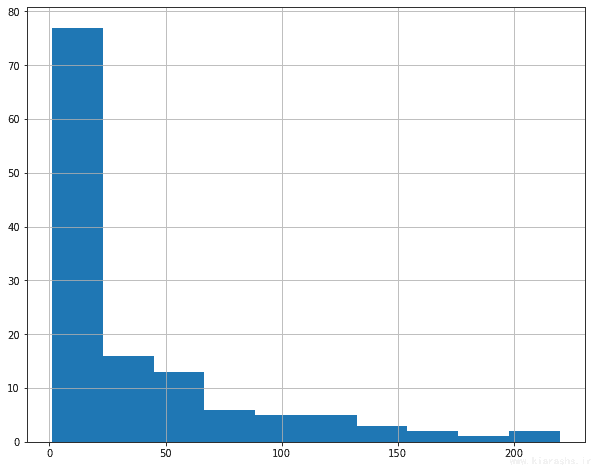
- Use
.agg()to calculate the mean and median ofco2_emissionfor rice.
rice_consumption = food_consumption[food_consumption['food_category'] == 'rice']
# Calculate mean and median of co2_emission with .agg()
print(rice_consumption.agg([np.mean, np.median]))
consumption co2_emission
mean 29.375154 37.591615
median 11.875000 15.200000
Given the skew of this data, what measure of central tendency best summarizes the kilograms of CO2 emissions per person per year for rice?
Answer:Median
Measures of spread
Quartiles, quantiles, and quintiles
Quantiles are a great way of summarizing numerical data since they can be used to measure center and spread, as well as to get a sense of where a data point stands in relation to the rest of the data set. For example, you might want to give a discount to the 10% most active users on a website.
In this exercise, you'll calculate quartiles, quintiles, and deciles, which split up a dataset into 4, 5, and 10 pieces, respectively.
print(np.quantile(food_consumption['co2_emission'],np.linspace(0, 1, 5)))
[ 0. 5.21 16.53 62.5975 1712. ]
print(np.quantile(food_consumption['co2_emission'],np.linspace(0, 1, 6)))
[ 0. 3.54 11.026 25.59 99.978 1712. ]
print(np.quantile(food_consumption['co2_emission'],np.linspace(0, 1, 10)))
[0.00000000e+00 9.05555556e-01 4.19111111e+00 8.05333333e+00
1.32000000e+01 2.10944444e+01 3.58666667e+01 7.90622222e+01
1.86115556e+02 1.71200000e+03]
Those are some high-quality quantiles! While calculating more quantiles gives you a more detailed look at the data, it also produces more numbers, making the summary more difficult to quickly understand.
Variance and standard deviation
Variance and standard deviation are two of the most common ways to measure the spread of a variable, and you'll practice calculating these in this exercise. Spread is important since it can help inform expectations. For example, if a salesperson sells a mean of 20 products a day, but has a standard deviation of 10 products, there will probably be days where they sell 40 products, but also days where they only sell one or two. Information like this is important, especially when making predictions.
Both pandas as pd and numpy as np are loaded, and food_consumption is available.
print(food_consumption.groupby('food_category')['co2_emission'].agg([np.var, np.std]))
# Import matplotlib.pyplot with alias plt
import matplotlib.pyplot as plt
# Create histogram of co2_emission for food_category 'beef'
food_consumption[food_consumption['food_category']=='beef'].hist()
# Show plot
plt.show()
# Create histogram of co2_emission for food_category 'eggs'
food_consumption[food_consumption['food_category']=='eggs'].hist()
# Show plot
plt.show()
var std
food_category
beef 88748.408132 297.906710
dairy 17671.891985 132.935669
eggs 21.371819 4.622966
fish 921.637349 30.358481
lamb_goat 16475.518363 128.356996
nuts 35.639652 5.969895
pork 3094.963537 55.632396
poultry 245.026801 15.653332
rice 2281.376243 47.763754
soybeans 0.879882 0.938020
wheat 71.023937 8.427570
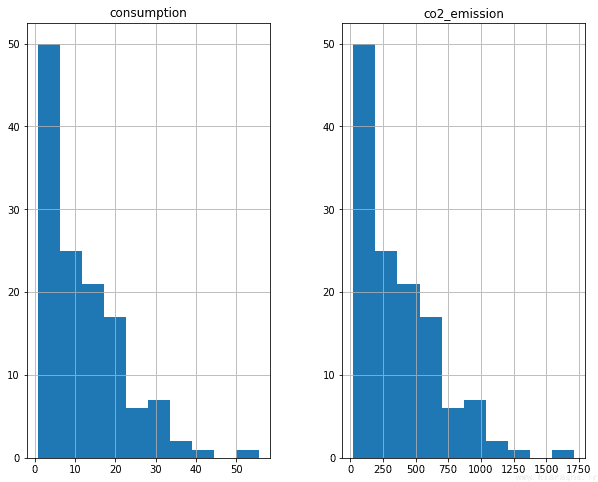
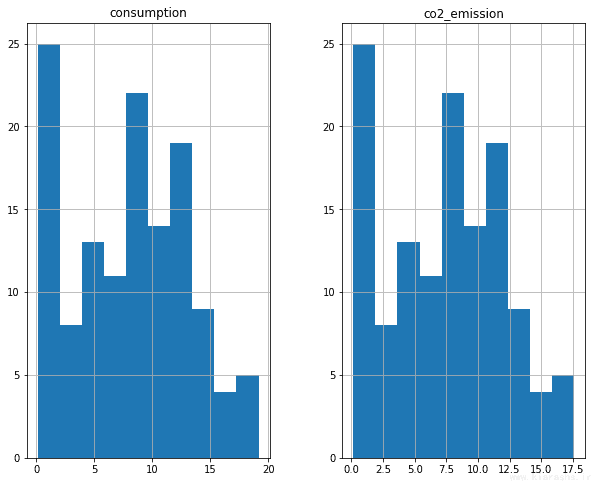
Beef has the largest amount of variation in its CO2 emissions, while eggs have a relatively small amount of variation.
Finding outliers using
Outliers can have big effects on statistics like mean, as well as statistics that rely on the mean, such as variance and standard deviation. Interquartile range, or , is another way of measuring spread that's less influenced by outliers. is also often used to find outliers. If a value is less than or greater than , it's considered an outlier.

In this exercise, you'll calculate and use it to find some outliers.
emissions_by_country = food_consumption.groupby('country')['co2_emission'].sum()
print(emissions_by_country)
country
Albania 1777.85
Algeria 707.88
Angola 412.99
Argentina 2172.40
Armenia 1109.93
...
Uruguay 1634.91
Venezuela 1104.10
Vietnam 641.51
Zambia 225.30
Zimbabwe 350.33
Name: co2_emission, Length: 130, dtype: float64
display(emissions_by_country.sort_values())
country
Mozambique 141.40
Rwanda 181.63
Togo 188.09
Liberia 203.38
Malawi 207.94
...
Iceland 1731.36
New Zealand 1750.95
Albania 1777.85
Australia 1938.66
Argentina 2172.40
Name: co2_emission, Length: 130, dtype: float64
emissions_by_country = food_consumption.groupby('country')['co2_emission'].sum()
# Compute the first and third quantiles and IQR of emissions_by_country
q1 = np.quantile(emissions_by_country, 0.25)
q3 = np.quantile(emissions_by_country, 0.75)
iqr = q3 - q1
# Calculate the lower and upper cutoffs for outliers
lower = q1 - 1.5 * iqr
upper = q3 + 1.5 * iqr
# Subset emissions_by_country to find outliers
outliers = emissions_by_country[(emissions_by_country > upper) | (emissions_by_country < lower)]
print(outliers)
country
Argentina 2172.4
Name: co2_emission, dtype: float64
Outstanding outlier detection! It looks like Argentina has a substantially higher amount of CO2 emissions per person than other countries in the world.
Random Numbers and Probability
In this section, you'll learn how to generate random samples and measure chance using probability. You'll work with real-world sales data to calculate the probability of a salesperson being successful. Finally, you’ll use the binomial distribution to model events with binary outcomes.
What are the chances?
- Measuring chance
What's the probability of an event?
With or without replacement?
For each scenario, decide whether it's sampling with replacement or sampling without replacement.

Correctly identifying the type of sampling that needs to be used is key to calculating accurate probabilities. With replacement, everyone always has a 5% chance of working on the weekend. Without replacement, the second pick has a 4/19 chance, and the third pick has a 3/18 chance of working on the weekend.
Calculating probabilities
You're in charge of the sales team, and it's time for performance reviews, starting with Amir. As part of the review, you want to randomly select a few of the deals that he's worked on over the past year so that you can look at them more deeply. Before you start selecting deals, you'll first figure out what the chances are of selecting certain deals.
Recall that the probability of an event can be calculated by:
amir_deals = pd.read_csv('./datasets/amir_deals.csv', index_col=0)
amir_deals.head()
| product | client | status | amount | num_users | |
|---|---|---|---|---|---|
| 1 | Product F | Current | Won | 7389.52 | 19 |
| 2 | Product C | New | Won | 4493.01 | 43 |
| 3 | Product B | New | Won | 5738.09 | 87 |
| 4 | Product I | Current | Won | 2591.24 | 83 |
| 5 | Product E | Current | Won | 6622.97 | 17 |
counts = amir_deals['product'].value_counts()
print(counts)
Product B 62
Product D 40
Product A 23
Product C 15
Product F 11
Product H 8
Product I 7
Product E 5
Product N 3
Product G 2
Product J 2
Name: product, dtype: int64
counts = amir_deals['product'].value_counts()
# Calculate probability of picking a deal with each product
probs = counts / len(amir_deals['product'])
print(probs)
Product B 0.348315
Product D 0.224719
Product A 0.129213
Product C 0.084270
Product F 0.061798
Product H 0.044944
Product I 0.039326
Product E 0.028090
Product N 0.016854
Product G 0.011236
Product J 0.011236
Name: product, dtype: float64
If you randomly select one of Amir's deals, what's the probability that the deal will involve Product C?
Ans:8.43%
Sampling deals
In the previous exercise, you counted the deals Amir worked on. Now it's time to randomly pick five deals so that you can reach out to each customer and ask if they were satisfied with the service they received. You'll try doing this both with and without replacement.
Additionally, you want to make sure this is done randomly and that it can be reproduced in case you get asked how you chose the deals, so you'll need to set the random seed before sampling from the deals.
Instructions:
- Set the random seed to 24.
- Take a sample of 5 deals without replacement and store them as
sample_without_replacement.
np.random.seed(24)
# Sample 5 deals without replacement
sample_without_replacement = amir_deals.sample(5, replace=False)
print(sample_without_replacement)
product client status amount num_users
128 Product B Current Won 2070.25 7
149 Product D Current Won 3485.48 52
78 Product B Current Won 6252.30 27
105 Product D Current Won 4110.98 39
167 Product C New Lost 3779.86 11
Take a sample of 5 deals with replacement and save as sample_with_replacement.
np.random.seed(24)
# Sample 5 deals with replacement
sample_with_replacement = amir_deals.sample(5, replace=True)
print(sample_with_replacement)
product client status amount num_users
163 Product D Current Won 6755.66 59
132 Product B Current Won 6872.29 25
88 Product C Current Won 3579.63 3
146 Product A Current Won 4682.94 63
146 Product A Current Won 4682.94 63
What type of sampling is better to use for this situation?
Answers:Without replacement
It's important to consider how you'll take a sample since there's no one-size-fits-all way to sample, and this can have an effect on your results.
Discrete distributions
Creating a probability distribution
A new restaurant opened a few months ago, and the restaurant's management wants to optimize its seating space based on the size of the groups that come most often. On one night, there are 10 groups of people waiting to be seated at the restaurant, but instead of being called in the order they arrived, they will be called randomly. In this exercise, you'll investigate the probability of groups of different sizes getting picked first. Data on each of the ten groups is contained in the restaurant_groups DataFrame.
Remember that expected value can be calculated by multiplying each possible outcome with its corresponding probability and taking the sum. The restaurant_groups data is available. pandas is loaded as pd, numpy is loaded as np, and matplotlib.pyplot is loaded as plt.
Instructions:
- Create a histogram of the
group_sizecolumn ofrestaurant_groups, setting bins to [2, 3, 4, 5, 6]. Remember to show the plot.
restaurant_groups = pd.read_csv('./datasets/restaurant_groups.csv')
restaurant_groups.head()
| group_id | group_size | |
|---|---|---|
| 0 | A | 2 |
| 1 | B | 4 |
| 2 | C | 6 |
| 3 | D | 2 |
| 4 | E | 2 |
restaurant_groups['group_size'].hist(bins=[2, 3, 4, 5, 6])
plt.show()
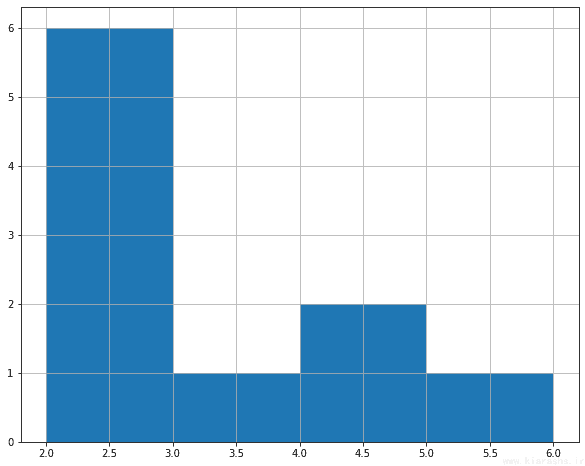
- Count the number of each group_size in
restaurant_groups, then divide by the number of rows inrestaurant_groupsto calculate the probability of randomly selecting a group of each size. Save assize_dist. - Reset the index of
size_dist. - Rename the columns of
size_disttogroup_sizeandprob.
size_dist = restaurant_groups['group_size'] / restaurant_groups.shape[0]
# Reset index and rename columns
size_dist = size_dist.reset_index()
size_dist.columns = ['group_size', 'prob']
print(size_dist)
group_size prob
0 0 0.2
1 1 0.4
2 2 0.6
3 3 0.2
4 4 0.2
5 5 0.2
6 6 0.3
7 7 0.2
8 8 0.4
9 9 0.2
- Calculate the expected value of the
size_distribution, which represents the expected group size, by multiplying thegroup_sizeby theproband taking the sum.
expected_value = (size_dist['group_size'] * size_dist['prob']).sum()
print(expected_value)
12.200000000000001
- Calculate the probability of randomly picking a group of 4 or more people by subsetting for groups of size 4 or more and summing the probabilities of selecting those groups.
size_dist = restaurant_groups['group_size'].value_counts() / restaurant_groups.shape[0]
# Reset index and rename columns
size_dist = size_dist.reset_index()
size_dist.columns = ['group_size', 'prob']
# Expected value
expected_value = np.sum(size_dist['group_size'] * size_dist['prob'])
# Subset groups of size 4 or more
groups_4_or_more = size_dist[size_dist['group_size'] >= 4]
# Sum the probabilities of groups_4_or_more
prob_4_or_more = groups_4_or_more['prob'].sum()
print(prob_4_or_more)
0.30000000000000004
Identifying distributions
Which sample is most likely to have been taken from a uniform distribution?

- A: bell-shaped distribution,
- B: relatively flat distribution,
- C: lots of lower values, fewer high values
Ans: B
Since the histogram depicts a sample and not the actual probability distribution, each outcome won't happen the exact same number of times due to randomness, but they're similar in number.
Expected value vs. sample mean
The app to the right will take a sample from a discrete uniform distribution, which includes the numbers 1 through 9, and calculate the sample's mean. You can adjust the size of the sample using the slider. Note that the expected value of this distribution is 5.
A sample is taken, and you win twenty dollars if the sample's mean is less than 4. There's a catch:you get to pick the sample's size. Which sample size is most likely to win you the twenty dollars?
- 10
- 100
- 1000
- 5000
- 10000
Ans: 10
Since the sample mean will likely be closer to 5 (the expected value) with larger sample sizes, you have a better chance of getting a sample mean further away from 5 with a smaller sample.
Continuous distributions
Which distribution?
Data back-ups
The sales software used at your company is set to automatically back itself up, but no one knows exactly what time the back-ups happen. It is known, however, that back-ups happen exactly every 30 minutes. Amir comes back from sales meetings at random times to update the data on the client he just met with. He wants to know how long he'll have to wait for his newly-entered data to get backed up. Use your new knowledge of continuous uniform distributions to model this situation and answer Amir's questions.
Instructions:
- To model how long Amir will wait for a back-up using a continuous uniform distribution, save his 2.lowest possible wait time as
min_timeand his longest possible wait time asmax_time. Remember that back-ups happen every 30 minutes. - Import
uniformfromscipy.statsand calculate the probability that Amir has to wait less than 5 minutes, and store in a variable calledprob_less_than_5. - Calculate the probability that Amir has to wait more than 5 minutes, and store in a variable called
prob_greater_than_5. - Calculate the probability that Amir has to wait between 10 and 20 minutes, and store in a variable called
prob_between_10_and_20.
min_time = 0
max_time = 30
# Import uniform from scipy.stats
from scipy.stats import uniform
# Calculate probability of waiting less than 5 mins
prob_less_than_5 = uniform.cdf(5, 0, 30)
print(prob_less_than_5)
# Calculate probability of waiting more than 5 mins
prob_greater_than_5 = 1 - uniform.cdf(5, 0, 30)
print(prob_greater_than_5)
# Calculate probability of waiting 10-20 mins
prob_between_10_and_20 = uniform.cdf(20, 0, 30) - uniform.cdf(10, 0, 30)
print(prob_between_10_and_20)
0.16666666666666666
0.8333333333333334
0.3333333333333333
Simulating wait times
To give Amir a better idea of how long he'll have to wait, you'll simulate Amir waiting 1000 times and create a histogram to show him what he should expect. Recall from the last exercise that his minimum wait time is 0 minutes and his maximum wait time is 30 minutes.
np.random.seed(334)
# Import uniform
from cProfile import label
from scipy.stats import uniform
# Generate 1000 wait times between 0 and 30 mins
wait_times = uniform.rvs(0, 30, size=1000)
# Create a histogram of simulated times and show plot
plt.hist(wait_times, rwidth=0.9)
plt.text(1.01, 0.85, f'average: {np.mean(wait_times):.2f} mins',
fontsize=12, transform=plt.gca().transAxes)
plt.show()
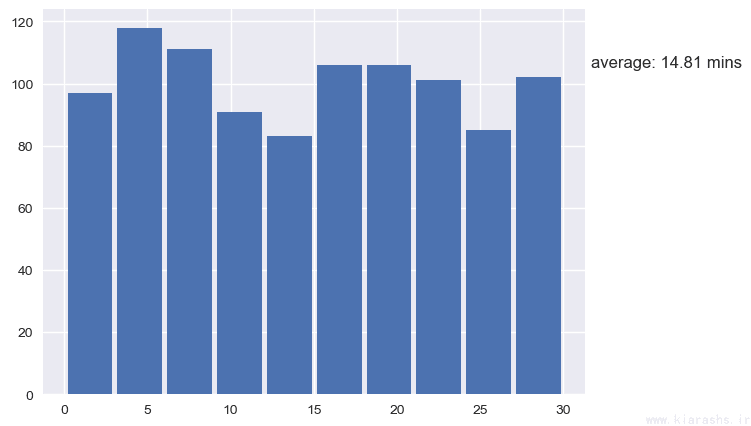
The binomial distribution
Simulating sales deals
Assume that Amir usually works on 3 deals per week, and overall, he wins 30% of deals he works on. Each deal has a binary outcome:it's either lost, or won, so you can model his sales deals with a binomial distribution. In this exercise, you'll help Amir simulate a year's worth of his deals so he can better understand his performance.
from scipy.stats import binom
# Set random seed to 10
np.random.seed(10)
# Simulate a single deal
print(binom.rvs(1, 0.3, size=1))
np.random.seed(10)
# Simulate 1 week of 3 deals
print(binom.rvs(3, 0.3, size=1))
np.random.seed(10)
# Simulate 52 weeks of 3 deals
deals = binom.rvs(3, 0.3, size=52)
# Print mean deals won per week
print(np.mean(deals))
[1]
[1]
0.8269230769230769
Calculating binomial probabilities
Just as in the last exercise, assume that Amir wins 30% of deals. He wants to get an idea of how likely he is to close a certain number of deals each week. In this exercise, you'll calculate what the chances are of him closing different numbers of deals using the binomial distribution.
binom is imported from scipy.stats.
prob_3 = binom.pmf(3,3,0.3)
print(prob_3)
# Probability of closing <= 1 deal out of 3 deals
prob_less_than_or_equal_1 = binom.cdf(1,3,0.3)
print(prob_less_than_or_equal_1)
# Probability of closing > 1 deal out of 3 deals
prob_greater_than_1 = 1 - binom.cdf(1, 3, 0.3)
print(prob_greater_than_1)
"""Amir has about a 22% chance of closing more than one deal in a week."""
0.026999999999999996
0.784
0.21599999999999997
'Amir has about a 22% chance of closing more than one deal in a week.'
How many sales will be won?
Now Amir wants to know how many deals he can expect to close each week if his win rate changes. Luckily, you can use your binomial distribution knowledge to help him calculate the expected value in different situations. The expected value of a binomial distribution can be calculated by .
Instructions:
- Calculate the expected number of sales out of the 3 he works on that Amir will win each week if he maintains his 30% win rate.
- Calculate the expected number of sales out of the 3 he works on that he'll win if his win rate drops to 25%.
- Calculate the expected number of sales out of the 3 he works on that he'll win if his win rate rises to 35%.
won_30pct = 0.3 * 3
print(won_30pct)
# Expected number won with 25% win rate
won_25pct = 0.25 * 3
print(won_25pct)
# Expected number won with 35% win rate
won_35pct = 0.35 * 3
print(won_35pct)
"""Excellent expectation experimentation! If Amir's win rate goes up by 5%, he can expect to close more than 1 deal on average each week."""
0.8999999999999999
0.75
1.0499999999999998
More Distributions and the Central Limit Theorem
It’s time to explore one of the most important probability distributions in statistics, normal distribution. You’ll create histograms to plot normal distributions and gain an understanding of the central limit theorem, before expanding your knowledge of statistical functions by adding the Poisson, exponential, and t-distributions to your repertoire.
The normal distribution
Distribution of Amir's sales
Since each deal Amir worked on (both won and lost) was different, each was worth a different amount of money. These values are stored in the amount column of amir_deals As part of Amir's performance review, you want to be able to estimate the probability of him selling different amounts, but before you can do this, you'll need to determine what kind of distribution the amount variable follows.
amir_deals = pd.read_csv('./datasets/amir_deals.csv', index_col=0)
amir_deals['amount'].hist( bins=10)
plt.show()
""" the sales amounts most closely follows the Normal probability distribution """
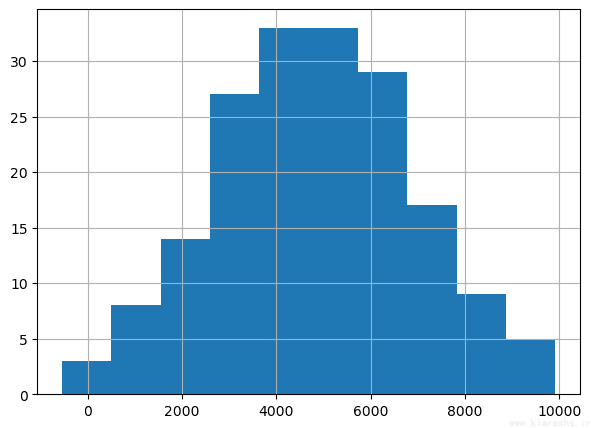
' the sales amounts most closely follows the Normal probability distribution '
Probabilities from the normal distribution
Since each deal Amir worked on (both won and lost) was different, each was worth a different amount of money. These values are stored in the amount column of amir_deals and follow a normal distribution with a mean of 5000 dollars and a standard deviation of 2000 dollars. As part of his performance metrics, you want to calculate the probability of Amir closing a deal worth various amounts.
from scipy.stats import norm
# Probability of deal < 7500
prob_less_7500 = norm.cdf(7500, 5000,2000)
print(prob_less_7500)
# Probability of deal > 1000
prob_over_1000 = 1 - norm.cdf(1000, 5000, 2000)
print(prob_over_1000)
# Probability of deal between 3000 and 7000
prob_3000_to_7000 = norm.cdf(7000, 5000,2000) - norm.cdf(3000,5000,2000)
print(prob_3000_to_7000)
# Calculate amount that 25% of deals will be less than
pct_25 = norm.ppf(0.25,5000,2000)
print(pct_25)
0.8943502263331446
0.9772498680518208
0.6826894921370859
3651.0204996078364
Simulating sales under new market conditions
The company's financial analyst is predicting that next quarter, the worth of each sale will increase by 20% and the volatility, or standard deviation, of each sale's worth will increase by 30%. To see what Amir's sales might look like next quarter under these new market conditions, you'll simulate new sales amounts using the normal distribution and store these in the new_sales DataFrame, which has already been created for you.
In addition, norm from scipy.stats, pandas as pd, and matplotlib.pyplot as plt are loaded.
Instructions:
- Currently, Amir's average sale amount is $5000. Calculate what his new average amount will be if it increases by 20% and store this in
new_mean. - Amir's current standard deviation is $2000. Calculate what his new standard deviation will be if it increases by 30% and store this in
new_sd. - Create a variable called
new_sales, which contains 36 simulated amounts from a normal distribution with a mean ofnew_meanand a standard deviation ofnew_sd. - Plot the distribution of the
new_salesamounts using a histogram and show the plot.
new_mean = 5000 * 1.2
# Calculate new standard deviation
new_sd = 2000 * 1.3
# Simulate 36 new sales
new_sales = norm.rvs(new_mean, new_sd, size=36)
# Create histogram and show
plt.hist(new_sales, rwidth=0.96)
plt.show()
""" Although the average sale amount went up, the variation also increased, so it's not straightforward to decide whether these sales are better than his current ones. In the next exercise, you'll explore the effects of higher variation."""
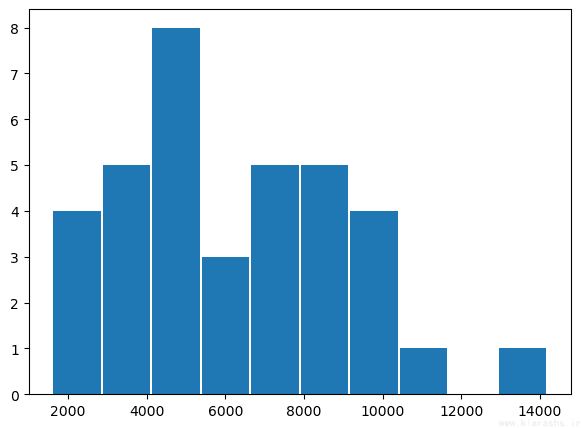
" Although the average sale amount went up, the variation also increased, so it's not straightforward to decide whether these sales are better than his current ones. In the next exercise, you'll explore the effects of higher variation."
Which market is better?
The key metric that the company uses to evaluate salespeople is the percent of sales they make over $1000 since the time put into each sale is usually worth a bit more than that, so the higher this metric, the better the salesperson is performing.
Recall that Amir's current sales amounts have a mean of , and Amir's predicted amounts in next quarter's market have a mean of .
Based only on the metric of percent of sales over $1000, does Amir perform better in the current market or the predicted market?
cur_market_sales_over_1000 = 1 - norm.cdf(1000,5000,2000)
print(cur_market_sales_over_1000)
predicted_market_sales_over_1000 = 1 - norm.cdf(1000,6000,2600)
print(predicted_market_sales_over_1000)
""" In the current market, Amir makes sales over $1000 about 97.7% of the time, and about 97.3% of the time in the predicted market, so there's not much of a difference. However, his average sale amount is higher in the predicted market, so your company may want to consider other metrics as well."""
0.9772498680518208
0.9727648049862613
" In the current market, Amir makes sales over $1000 about 97.7% of the time, and about 97.3% of the time in the predicted market, so there's not much of a difference. However, his average sale amount is higher in the predicted market, so your company may want to consider other metrics as well."
The central limit theorem
Visualizing sampling distributions
Try creating sampling distributions of different summary statistics from samples of different distributions. Which distribution does the central limit theorem not apply to?
- Discrete uniform distribution
- Continuous uniform distribution
- Binomial distribution
- All of the above
- None of the above
Regardless of the shape of the distribution you're taking sample means from, the central limit theorem will apply if the sampling distribution contains enough sample means.
The CLT in action
The central limit theorem states that a sampling distribution of a sample statistic approaches the normal distribution as you take more samples, no matter the original distribution being sampled from.
In this exercise, you'll focus on the sample mean and see the central limit theorem in action while examining the num_users column of amir_deals more closely, which contains the number of people who intend to use the product Amir is selling.
pandas as pd, numpy as np, and matplotlib.pyplot as plt are loaded and amir_deals is available.
Instructions: Create a histogram of the num_users column of amir_deals and show the plot.
amir_deals['num_users'].hist()
plt.show()
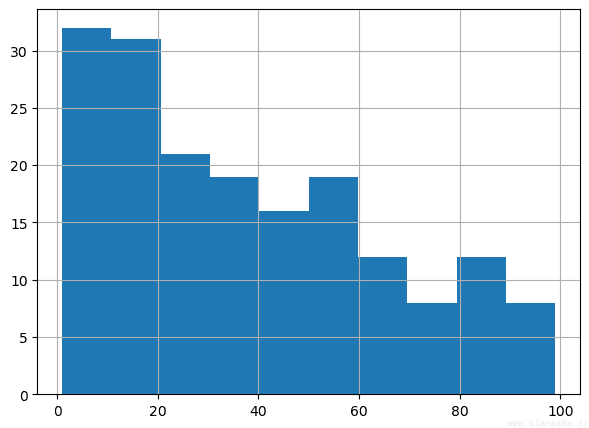
np.random.seed(104)
sample_means = []
# Loop 100 times
for i in range(100):
# Take sample of 20 num_users
samp_20 = amir_deals['num_users'].sample(20, replace=True)
# Calculate mean of samp_20
samp_20_mean = np.mean(samp_20)
# Append samp_20_mean to sample_means
sample_means.append(samp_20_mean)
# Convert to Series and plot histogram
sample_means_series = pd.Series(sample_means)
sample_means_series.hist()
# Show plot
plt.show()
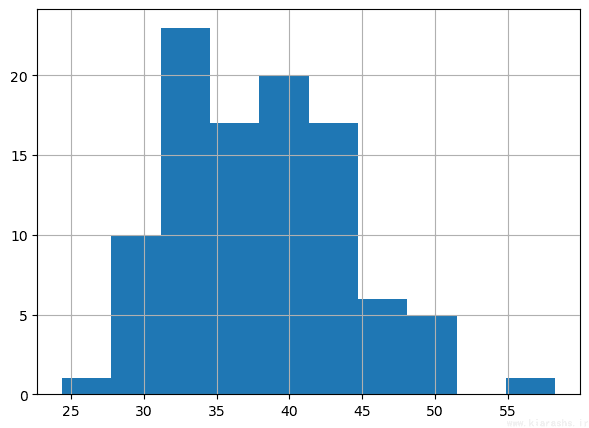
The mean of means
You want to know what the average number of users (num_users) is per deal, but you want to know this number for the entire company so that you can see if Amir's deals have more or fewer users than the company's average deal. The problem is that over the past year, the company has worked on more than ten thousand deals, so it's not realistic to compile all the data. Instead, you'll estimate the mean by taking several random samples of deals, since this is much easier than collecting data from everyone in the company.
all_deals = pd.read_csv('./datasets/all_deals.csv', index_col=0)
all_deals.info()
<class 'pandas.core.frame.DataFrame'>
Int64Index: 10548 entries, 0 to 10547
Data columns (total 3 columns):
# Column Non-Null Count Dtype
--- ------ -------------- -----
0 Unnamed: 0 10548 non-null int64
1 product 10548 non-null int64
2 num_users 10548 non-null int64
dtypes: int64(3)
memory usage: 329.6 KB
np.random.seed(321)
sample_means = []
# Loop 30 times to take 30 means
for i in range(30):
# Take sample of size 20 from num_users col of all_deals with replacement
cur_sample = all_deals['num_users'].sample(20, replace=True)
# Take mean of cur_sample
cur_mean = np.mean(cur_sample)
# Append cur_mean to sample_means
sample_means.append(cur_mean)
# Print mean of sample_means
print(np.mean(sample_means))
# Print mean of num_users in amir_deals
print(np.mean(amir_deals['num_users']))
""" Amir's average number of users is very close to the overall average, so it looks like he's meeting expectations. Make sure to note this in his performance review! """
38.31333333333332
37.651685393258425
" Amir's average number of users is very close to the overall average, so it looks like he's meeting expectations. Make sure to note this in his performance review! "
The Poisson distribution
Identifying lambda
Now that you've learned about the Poisson distribution, you know that its shape is described by a value called lambda. In this exercise, you'll match histograms to lambda values.
Instructions:
- Match each Poisson distribution to its lambda value.
Ans:

The Poisson distribution is a family of distributions, just like the uniform, binomial, or normal distributions.
Tracking lead responses
Your company uses sales software to keep track of new sales leads. It organizes them into a queue so that anyone can follow up on one when they have a bit of free time. Since the number of lead responses is a countable outcome over a period of time, this scenario corresponds to a Poisson distribution. On average, Amir responds to 4 leads each day. In this exercise, you'll calculate probabilities of Amir responding to different numbers of leads.
Instructions:
- Import
poissonfromscipy.statsand calculate the probability that Amir responds to 5 leads in a day, given that he responds to an average of 4. - Amir's coworker responds to an average of 5.5 leads per day. What is the probability that she answers 5 leads in a day?
- What's the probability that Amir responds to 2 or fewer leads in a day?
- What's the probability that Amir responds to more than 10 leads in a day?
from scipy.stats import poisson
# Probability of 5 responses
prob_5 = poisson.pmf(5,4)
print(prob_5)
0.1562934518505317
prob_coworker =poisson.pmf(5,5.5)
print(prob_coworker)
0.17140068409793663
prob_2_or_less = poisson.cdf(2,4)
print(prob_2_or_less)
0.23810330555354436
prob_over_10 = 1 - poisson.cdf(10,4)
print(prob_over_10)
0.0028397661205137315
Note that if you provide poisson.pmf() or poisson.cdf() with a non-integer, it throws an error since the Poisson distribution only applies to integers.
More probability distributions
Distribution dragging and dropping
By this point, you've learned about so many different probability distributions that it can be difficult to remember which is which. In this exercise, you'll practice distinguishing between distributions and identifying the distribution that best matches different scenarios.

Modeling time between leads
To further evaluate Amir's performance, you want to know how much time it takes him to respond to a lead after he opens it. On average, it takes 2.5 hours for him to respond. In this exercise, you'll calculate probabilities of different amounts of time passing between Amir receiving a lead and sending a response.
Instructions:
- Import
exponfromscipy.stats. What's the probability it takes Amir less than an hour to respond to a lead? - What's the probability it takes Amir more than 4 hours to respond to a lead?
- What's the probability it takes Amir 3-4 hours to respond to a lead?
from scipy.stats import expon
# Print probability response takes < 1 hour
print(expon.cdf(1, scale=2.5))
# Print probability response takes > 4 hours
print(1 - expon.cdf(4,scale=2.5))
# Print probability response takes 3-4 hours
print(expon.cdf(4,scale=2.5) - expon.cdf(3,scale=2.5))
"""There's only about a 20% chance it will take Amir more than 4 hours to respond, so he's pretty speedy in his responses."""
0.3296799539643607
0.20189651799465536
0.09929769391754684
"There's only about a 20% chance it will take Amir more than 4 hours to respond, so he's pretty speedy in his responses."
The t-distribution
Which statement is not true regarding the t-distribution?
Possible Answers
- The t-distribution has thicker tails than the normal distribution.
- A t-distribution with high degrees of freedom resembles the normal distribution.
- The number of degrees of freedom affects the distribution's variance.
- The t-distribution is skewed.
Correlation and Experimental Design
In this section, you'll learn how to quantify the strength of a linear relationship between two variables, and explore how confounding variables can affect the relationship between two other variables. You'll also see how a study’s design can influence its results, change how the data should be analyzed, and potentially affect the reliability of your conclusions.
Correlation
Guess the correlation
On the right, use the scatterplot to estimate what the correlation is between the variables and . Once you've guessed it correctly, use the New Plot button to try out a few more scatterplots. When you're ready, answer the question below to continue to the next exercise.
Which of the following statements is NOT true about correlation?
Instructions:
- If the correlation between and has a high magnitude, the data points will be clustered closely around a line.
- Correlation can be written as .
- If and are negatively correlated, values of decrease as values of increase.
- Correlation cannot be 0.
When correlation is 0, that means there is no relationship between two variables and the points appear to be randomly scattered.
Relationships between variables
In this section, you'll be working with a dataset world_happiness containing results from the 2019 World Happiness Report. The report scores various countries based on how happy people in that country are. It also ranks each country on various societal aspects such as social support, freedom, corruption, and others. The dataset also includes the GDP per capita and life expectancy for each country. In this exercise, you'll examine the relationship between a country's life expectancy (life_exp) and happiness score (happiness_score) both visually and quantitatively. seaborn as sns, matplotlib.pyplot as plt, and pandas as pd are loaded and world_happiness is available.
import seaborn as sns
world_happiness = pd.read_csv('./datasets/world_happiness.csv', index_col=0)
world_happiness.info()
<class 'pandas.core.frame.DataFrame'>
Int64Index: 143 entries, 1 to 143
Data columns (total 8 columns):
# Column Non-Null Count Dtype
--- ------ -------------- -----
0 country 143 non-null object
1 social_support 142 non-null float64
2 freedom 142 non-null float64
3 corruption 135 non-null float64
4 generosity 142 non-null float64
5 gdp_per_cap 143 non-null int64
6 life_exp 143 non-null float64
7 happiness_score 143 non-null int64
dtypes: float64(5), int64(2), object(1)
memory usage: 10.1+ KB
sns.scatterplot(x='life_exp', y='happiness_score', data=world_happiness)
# Show plot
plt.show()
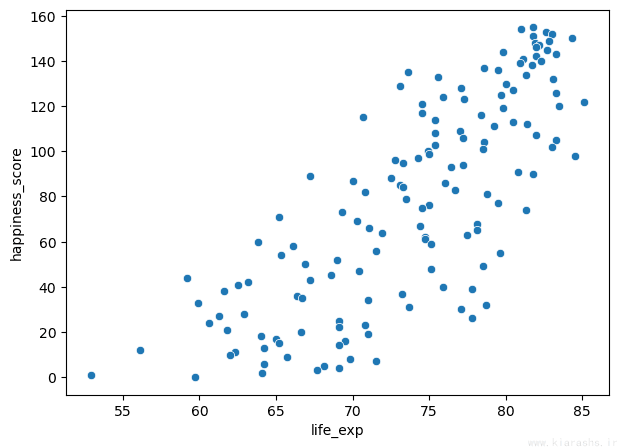
sns.lmplot(x='life_exp', y='happiness_score', data=world_happiness, ci=None)
# Show plot
plt.show()
# Correlation between life_exp and happiness_score
cor = world_happiness['life_exp'].corr(world_happiness['happiness_score'])
print(cor)
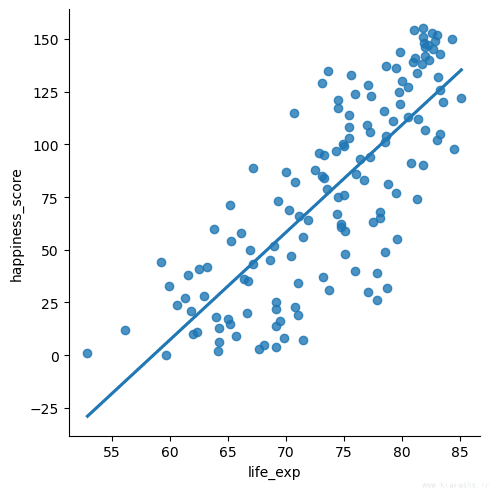
0.7802249053272062
Based on the scatterplot, which is most likely the correlation between life_exp and happiness_score?
Ans: 0.8
Correlation caveats
What can't correlation measure?
While the correlation coefficient is a convenient way to quantify the strength of a relationship between two variables, it's far from perfect. In this exercise, you'll explore one of the caveats of the correlation coefficient by examining the relationship between a country's GDP per capita (gdp_per_cap) and happiness score.
sns.scatterplot(x='gdp_per_cap', y='life_exp', data=world_happiness)
# Show plot
plt.show()
# Correlation between gdp_per_cap and life_exp
cor = world_happiness['gdp_per_cap'].corr(world_happiness['life_exp'])
print(cor)
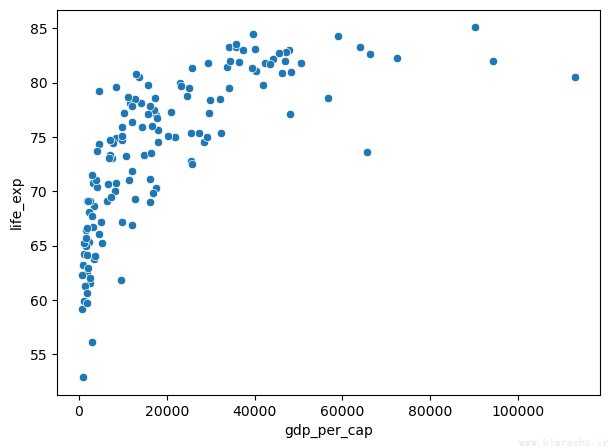
0.7019547642148012
The correlation between GDP per capita and life expectancy is 0.7. Why is correlation not the best way to measure the relationship between these two variables?
Possible Answers:
- Correlation measures how one variable affects another.
- Correlation only measures linear relationships.
- Correlation cannot properly measure relationships between numeric variables.
Transforming variables
When variables have skewed distributions, they often require a transformation in order to form a linear relationship with another variable so that correlation can be computed. In this exercise, you'll perform a transformation yourself.
pandas as pd, numpy as np, matplotlib.pyplot as plt, and seaborn as sns are imported, and world_happiness is loaded.
Instructions:
- Create a scatterplot of
happiness_scoreversusgdp_per_capand calculate the correlation between them. - Add a new column to
world_happinesscalledlog_gdp_per_capthat contains the log ofgdp_per_cap. - Create a seaborn scatterplot of
log_gdp_per_capandhappiness_scoreand calculate the correlation between them.
sns.scatterplot(x='gdp_per_cap', y='happiness_score', data=world_happiness)
plt.show()
# Calculate correlation
cor = world_happiness['gdp_per_cap'].corr(world_happiness['happiness_score'])
print(cor)
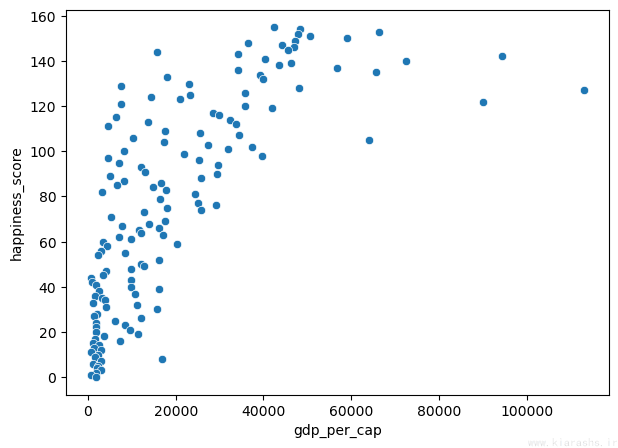
0.727973301222298
world_happiness['log_gdp_per_cap'] = np.log(world_happiness['gdp_per_cap'])
# Scatterplot of log_gdp_per_cap and happiness_score
sns.scatterplot(x='log_gdp_per_cap', y='happiness_score', data=world_happiness)
plt.show()
# Calculate correlation
cor = world_happiness['log_gdp_per_cap'].corr(world_happiness['happiness_score'])
print(cor)
"""The relationship between GDP per capita and happiness became more linear by applying a log transformation. Log transformations are great to use on variables with a skewed distribution, such as GDP."""
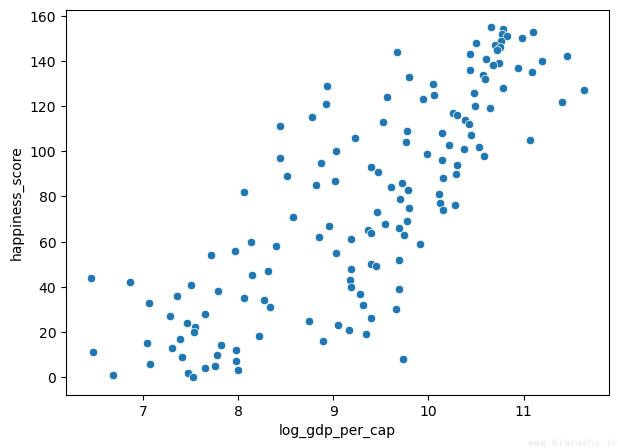
0.8043146004918288
'The relationship between GDP per capita and happiness became more linear by applying a log transformation. Log transformations are great to use on variables with a skewed distribution, such as GDP.'
Does sugar improve happiness?
A new column has been added to world_happiness called grams_sugar_per_day, which contains the average amount of sugar eaten per person per day in each country. In this exercise, you'll examine the effect of a country's average sugar consumption on its happiness score.
pandas as pd, matplotlib.pyplot as plt, and seaborn as sns are imported, and world_happiness is loaded.
Question: Based on this data, which statement about sugar consumption and happiness scores is true?
Possible Answers:
- Increased sugar consumption leads to a higher happiness score.
- Lower sugar consumption results in a lower happiness score
- Increased sugar consumption is associated with a higher happiness score.
- Sugar consumption is not related to happiness.
import seaborn as sns
world_happiness = pd.read_csv('./datasets/world_happiness_add_sugar.csv', index_col=0)
world_happiness.info()
<class 'pandas.core.frame.DataFrame'>
Int64Index: 133 entries, 0 to 132
Data columns (total 10 columns):
# Column Non-Null Count Dtype
--- ------ -------------- -----
0 Unnamed: 0 133 non-null int64
1 country 133 non-null object
2 social_support 133 non-null int64
3 freedom 133 non-null int64
4 corruption 127 non-null float64
5 generosity 133 non-null int64
6 gdp_per_cap 133 non-null int64
7 life_exp 133 non-null float64
8 happiness_score 133 non-null int64
9 grams_sugar_per_day 133 non-null float64
dtypes: float64(3), int64(6), object(1)
memory usage: 11.4+ KB
sns.scatterplot(x='grams_sugar_per_day', y='happiness_score', data=world_happiness)
plt.show()
# Correlation between grams_sugar_per_day and happiness_score
cor = world_happiness['grams_sugar_per_day'].corr(world_happiness['happiness_score'])
print(cor)
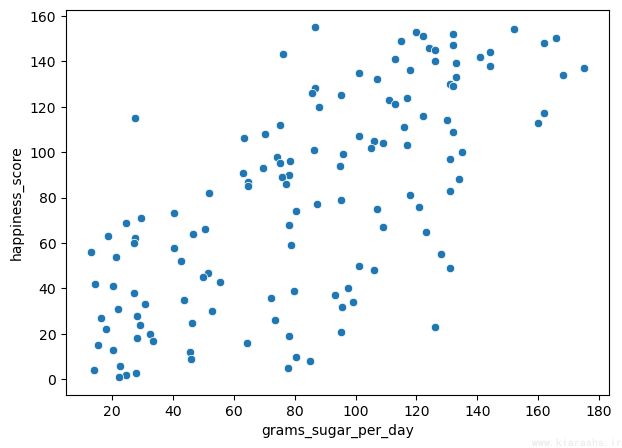
0.6939100021829633
Confounders
A study is investigating the relationship between neighborhood residence and lung capacity. Researchers measure the lung capacity of thirty people from neighborhood A, which is located near a highway, and thirty people from neighborhood B, which is not near a highway. Both groups have similar smoking habits and a similar gender breakdown.
Which of the following could be a confounder in this study?
Possible Answers:
- Lung capacity
- Neighborhood
- Air pollution
- Smoking status
- Gender
Design of experiments
Study types

Longitudinal vs. cross-sectional studies
Longitudinal vs. cross-sectional studies A company manufactures thermometers, and they want to study the relationship between a thermometer's age and its accuracy. To do this, they take a sample of 100 different thermometers of different ages and test how accurate they are. Is this data longitudinal or cross-sectional?
Possible Answers:
- Longitudinal
- Cross-sectional
- Both
- Neither
This is a cross-sectional study since researchers aren't following the same set of thermometers over time and repeatedly measuring their accuracy at different ages.